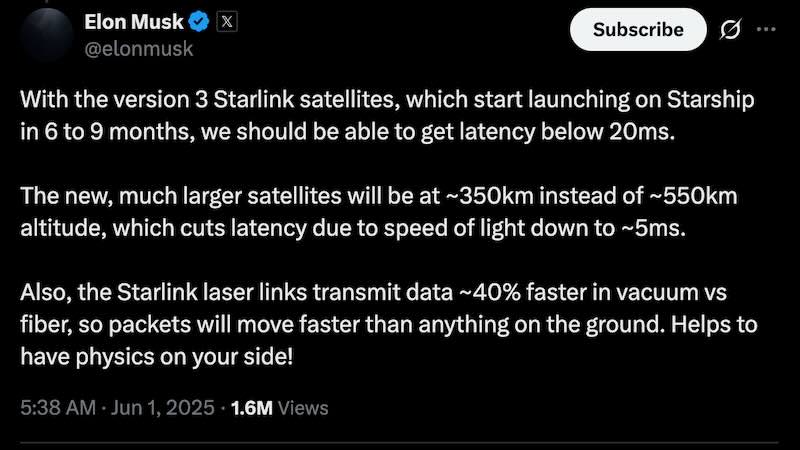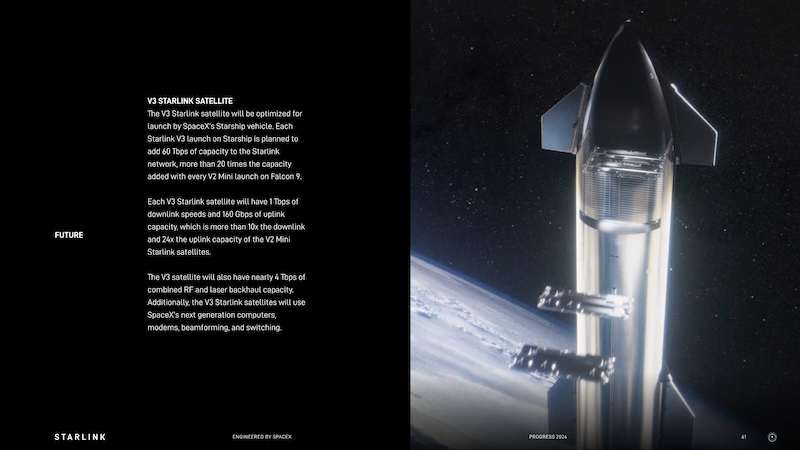SpaceX CEO Elon Musk has announced an ambitious timeline for launching next-generation Starlink V3 satellites, claiming the first units will reach orbit within 6 to 9 months. Starlink V3 satellites represent a significant leap forward in satellite internet technology, promising latency below 20 milliseconds and gigabit download speeds. However, this timeline depends on several factors, including Starship’s readiness and regulatory approval from the Federal Communications Commission.
Elon outlined his vision for reducing Starlink latency during a X post. “With the version 3 Starlink satellites, which start launching on Starship in 6 to 9 months, we should be able to get latency below 20ms,” he tweeted, explaining that physics will work in SpaceX’s favor through lower orbital altitudes and faster data transmission through space.

Elon Musk has announced an ambitious timeline for launching next-generation Starlink V3 satellites
The technical specifications for Starlink V3 satellites showcase substantial improvements over current models. Each V3 unit will feature 1 terabit per second of download bandwidth — a 10 fold increase compared to V2 satellites currently in orbit. Enhanced capacity aims to deliver gigabit speeds to subscribers, bringing satellite internet performance closer to premium fiber connections.
SpaceX plans to position these Starlink V3 satellites at approximately 350 kilometers altitude, significantly lower than the current 550-kilometer orbital height. Altitude reduction will cut speed-of-light latency to roughly 5 milliseconds, representing a major improvement in signal transmission times. SpaceX also highlighted that laser links between satellites can transmit data 40% faster in vacuum compared to fiber optic cables, giving Starlink V3 satellites a speed advantage over terrestrial networks.
The Starlink V3 deployment timeline faces a critical dependency on Starship’s operational readiness. SpaceX intends to use its next-gen launch vehicle exclusively for V3 satellite deployments, but Starship remains in testing phases without a completed successful space mission. Reliance on unproven technology introduces uncertainty into Elon’s 6 to 9 month projection for initial launches.
Previous Starlink predictions from Elon haven’t always materialized on schedule. In 2023, he suggested V3 satellite deployment would begin in 2024, a timeline that clearly didn’t materialize. These missed predictions raise questions about whether the current timeline represents realistic expectations or optimistic projections.
Subscribers hoping to access Starlink V3 satellites’ enhanced capabilities will likely need new hardware. SpaceX is developing updated Starlink dishes designed specifically to handle gigabit speeds from the improved satellite constellation. This hardware requirement means existing customers may face additional costs to fully utilize V3 performance improvements.
The company’s manufacturing ambitions for Starlink V3 satellites scale dramatically over time. Initial production targets call for 5k units annually, eventually ramping up to nearly 10k satellites per year. Production schedule suggests SpaceX envisions deploying thousands of V3 units to create a comprehensive next-generation network.
SpaceX’s plans for 350-kilometer orbital altitudes require Federal Communications Commission approval, which hasn’t been granted yet. FCC is currently reviewing SpaceX’s request to operate close to 30k Starlink satellites, and the proposed lower orbits add complexity to this regulatory process. Without FCC approval, the technical advantages of reduced altitude won’t be achievable.
Current Starlink service offers latency as low as 22 milliseconds in optimal conditions, compared to ground-based internet’s typical 12-millisecond average. Achieving sub-20-millisecond performance would significantly close this gap and make satellite internet more competitive with traditional broadband services.
With physics on their side and ambitious timelines ahead, SpaceX appears ready to satellite-link the gap between current performance and next-generation capabilities.
Related Post
Elon Mars Presentation: Starship V3 Launch 2025, Tesla Optimus Robots to Mars 2027
SpaceX Starship Flight 9: Booster Reflight Success Ends in Explosive Upper Stage Failure
SpaceX New Starlink Dish to Deliver Gigabit Internet Speeds, Rivaling Fiber Networks
